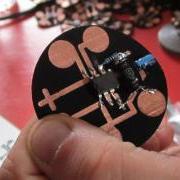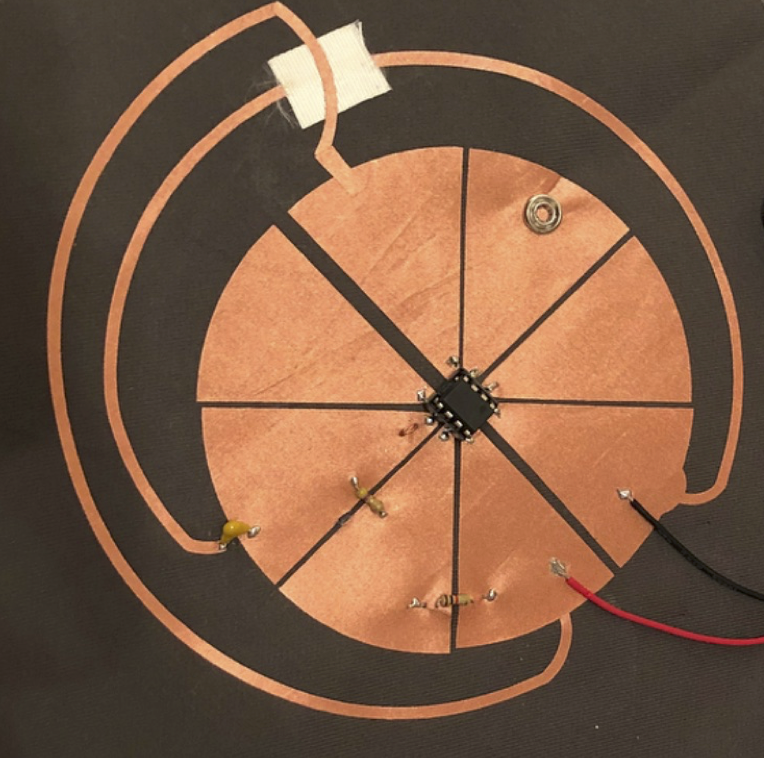- David Wessel’s IRCAM
- Organized Entanglement: Fiber and Textile Arts, Science and Engineering
- Managing Complexity with Explicit Mapping of Gestures to Sound Control with OSC
- Notations for Performative Electronics: the case of the CMOS Varactor
- A Synthesizable Hybrid VCO using SkyWater 130nm Standard-Cell Multiplexers
- A Recipe using OSC Messages
- Birds of the East Bay 2020
- Exercising the odot language in Graphics Animation Applications
- C++ container output stream header file
- Programming
textile
Celebrating Valérie Lamontagne
Wed, 10/09/2019 - 13:47 — AdrianFreed
Last week the world of wearables lost the light of one our shining stars, Valérie Lamontagne.
I invite you to celebrate her life by reading, citing and responding in your own way to one of her major life’s works: her 2017 dissertation: “Performative Wearables: Bodies, Fashion, and Technology”.
You can find it here: https://spectrum.library.concordia.ca/982473/
She covers some examples used in her dissertation here: https://vimeo.com/196041125
Valérie’s dissertation contributes to the field of wearables by carefully and clearly looking at our field with a combination of two powerful lenses: performativity and non-human agency. Performativity is a well-established lens articulated by Austin for speech acts, made popular by its use for gender by Judith Butler, for power by Jean-François Lyotard, and Karen Barad for cultural and feminist studies of science. Explorations of non-human agency have taken on a recent urgency from the extinction and climate crises. Both these lenses have a long, interesting, convoluted intellectual history so I especially appreciate Valérie’s approach of using extensive case studies of applications familiar to us as a “soft” way into learning the conceptual underpinnings.
What might you be able to do with the deeper understanding that comes from reading this work? It can give you a grasp on the thorny problem of cultural uptake- which designs will have lasting impact? Why do we see the same designs (tropes) being recycled in the field, e.g., cellphone/music player controlling backpacks? It can deepen understanding and appreciation of recent exploratory work in the field. For example, Hannah Perner-Wilson, has been exploring and celebrating the humble pin. She has moved from from pin as a tool, to pin as a material and in her recent whimsical work to pin as an active agent with its own agendas.
I was using performativity, non-human agency and related lenses in my studies of the history of electronic musical instruments while I was in the same program as Valérie at Concordia (INDI). As I surveyed images of the labs. where these musical instruments were created in the last 100 years, I saw one piece of apparatus “photobombing” every picture: the oscilloscope. I no longer see this as a prop or minor tool of the trade. As a non-neutral visualizer of certain sounds it has huge agency over what these electronic musical instruments did. It delayed the adoption of “noisy” and “chaotic” sounds because they don’t visualize well on the traditional oscilloscope. And so it is with the battery of wearable technology. The battery’s promise to deliver power is underwritten by our promise to recharge them. This agency of entrainment has induced “range anxiety” ever since the wearables of the nineteenth century to modern electric vehicles.
As Melissa Coleman and Troy Nachtigall just pointed out, Valérie Lamontagne, did not have a chance to expand and broadly diffuse the fruits of her Ph. D. labor. Dissertation work can easily get lost in libraries and obscure university web sites because it isn’t indexed as well as conference/journal/book publications. It has only 4 citations in scholar.google.com as I write this.
Even as we struggle with our shock and sorrow, let’s read and share her deep and valuable work.
Circuit Layout Design Patterns for eTextiles Appliqués with Conductive Fabric
Sun, 04/22/2018 - 16:34 — AdrianFreedThis style is not convenient for eTextile Appliqués which are most commonly single-sided and are based on cut traces rather than etched boards.
There is an older style of PCB layout that is more suitable for low-speed e-textiles that I remember seeing with old transistor radios. The style is almost all copper with just a few lines etched away to separate conductors.
This makes designs more robust with multiple parts soldered on and removed and with multiple sewing points at the edges.
It also makes for less weeding and more surface area that will be fused/glued to the base fabric.

It was also common for many of the traces in these radios to be curved.
For the eTextile Spring Break I guided Martin De Bie through some iterations of his original Textilo design that includes this new thinking on layout and a further insight regarding the 8-pin DIP packages commonly used now by eTextile electronics experiments (with the ATTINY and 555 timer being common choices). This insight is to start the design from the DIP package and imagine the negative space of the smallest amount of conductive fabric that needs to be weeded to separate the 8 pins and combine the constraint of roughly equal area given to the conductors attached to each pin. This results in a motif with 8 radial lines and 8 triangles between them.
Here is the original textilo with its elegant pads to sew to:

Here is the next version with more conductive material to work with alongside the prototype of a radial design. The radial design includes serpentine interdigitation to allow for touch interaction:

Nicole Yi Messier picked up on this radial design pattern for her wearable 555 timer based FM radio transmitter:

- AdrianFreed's blog
- Login or register to post comments
Sound Making Technologies Ordered by Increasing Complexity/Cost/Size
Sun, 04/22/2018 - 15:36 — AdrianFreed| Approach | Example | Link |
|---|---|---|
| non-electronic | Lamello | http://bid.berkeley.edu/papers/chi/lamello_passive_acoustic_sensi/ |
| *Analog relaxation oscillator | Textilo | http://www.martindebie.com/research_project/textilo/ |
| Analog harmonic oscillator | self-resonating VCF | http://electronotes.netfirms.com/EN215.pdf |
| *Digital relaxation oscillator | Arduino Tone | https://github.com/adrianfreed/FastTouch |
| *Digital relaxation oscillator | Mozzi (LUT) | https://github.com/sensorium/Mozzi/blob/master/examples/01.Basics/Sinewa... |
| *Digital Modulation Synthesis | Mozzi (FM) | https://github.com/sensorium/Mozzi/tree/master/examples/06.Synthesis/FMs... |
| *Digital Subtractive Synthesis | Talkie (LPC Speech and singing) |
https://github.com/adrianfreed/Talkie |
| Unit Generator Library | Teensy Audio Library | https://www.pjrc.com/teensy/td_libs_Audio.html |
| Sampling "Synthesis" | Tone.js (Tone.Player) | https://tonejs.github.io |
| Dynamically Patched Unit Generators | Bela (libpd) | https://bela.io |
| Dynamically Patched Unit Generators with Image Synthesis |
Max/MSP/Jitter | https://cycling74.com/products/max |
| Analog Patched Modular | Modular | https://en.wikipedia.org/wiki/Modular_synthesizer |
- AdrianFreed's blog
- Login or register to post comments
Introduction to Relaxation Oscillators
Wed, 04/11/2018 - 17:20 — AdrianFreed- AdrianFreed's blog
- Login or register to post comments
Where there is a Whug there is a Way: Triaxial e-textile Breadboard
Sun, 07/16/2017 - 01:16 — AdrianFreedDescription:
Rectangular grids are dominant forms in electronics and textiles. Triaxial grids have not been explored in e-textile work so this breadboard is offered to begin these explorations. Triaxial grids sample the plane with higher density and the availability of whug connections as well as warp and woof simplifies circuits by providing a natural power/ground/signal triple.
Making:
The basic 3x3x3 configuration is made by sticking conductive copper tape on strips of basket-weaving reed. This is intended to evoke the thousands of year old traditions of basket weaving and invite 3-d explorations.
Card stock is easier to procure and stick the tape to. The idea is to use a substrate that won’t burn when you solder to the tape. Substitute fabric ribbons if you are going to sew to the breadboard instead.
I used pins to lock down two of parallel rows of 3 strips and then slid in the final row, guiding them over and under as required. The example has charlieplexed LED’s soldered on but this is just to start you thinking about how you might use such a dense array of available conductors.
Consider replacing a central strip with one with copper tape on both sides. Work out which conductors are then connected. Now consider sandwiching piezoresistive fabric between intersecting conductors. Can you use this to read an array of pressures sensors?
References/Inspirations:
core memory beading
triaxial textiles
basket weaving
multitouch
Materials: Cane, copper tape
Techniques: Weaving
The provided swatches will just be the breadboard. Illustrated are some LED’s controlled by Charlieplexing.
Circuit Diagram:
http://www.pcbheaven.com/wikipages/Charlieplexing/
- AdrianFreed's blog
- Login or register to post comments

